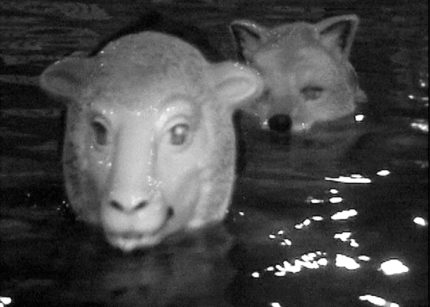Performing Paralinguay, 2000
Gary Hill and Paulina Wallenberg-Olsson
Intermedia performance for digital video camcorder with infrared, prerecorded digital video cassette, Lightening II synthesizer and controlling wand sticks, sound system, strobe light, variable number of whistles, elaborate white “Gothic/baby doll” dress, football shoulder pads, generic head gear, two live miniature horses and a dead cat
This work was first performed in Buenos Aires at the Centro Cultural Recoleta on May 28, 2000. A related shortened version took place at the “Anything Goes” conference held at the Guggenheim Museum on June 1-3, 2000, in New York. The conference consisted of several panel discussions amongst contemporary architects, theorists, and artists. The two performers were part of the panel, Thing as Feeling: ‘do your own thing.’
Performing Paralinguay opens with the protagonist (Paulina Wallenberg-Olsson) entering a completely dark stage from a side wing. Center stage is a freestanding 9 x 12 foot projection screen. The protagonist can only be seen on the screen via an infrared video camera. She sings a song cycle of several ancient Nordic songs a cappella and then silently leaves the stage. The screen is then moved off stage, thereby turning a black theatrical curtain into a new “dark screen.” Infrared black-and-white images of various small places (that might have been children’s hiding places: rooms, alcoves, storage spaces containing performers’ belongings left behind, various pieces of furniture, etc.) are projected on the velvety black curtain as slow, crossed dissolves lend a new depth to the image. Some thirty whistles had been passed out to the audience for improvisation during this segment to the effect that for about ten minutes different parts of the space seem to be calling out. Then the protagonist, now reaching the center of the balcony overlooking the space, once again breaks into song. Again she is completely in the dark, but this time with no camera and no images. Next a prerecorded silent segment of people wearing animal masks and swimming is projected onto the black curtain in extreme slow motion. The protagonist returns to the edge of the main stage where she sits and sings a lullaby to a dead cat with open eyes. Due to the way an infrared camera handles brightness and contrast, an uncanny resemblance between the eyes of protagonist and cat creates an otherworldly bond between life and death. Final segment: a young child deploys special electronic “wand sticks” that control simple drum sounds, signaling people and horses (amidst the audience) to proceed outside, perhaps to a place with a terrace and view (specifics determined by given site). The protagonist then sings a final song: the 12th century ballad, Sven in the Garden of Roses, in which a mother asks one of her sons where he has been, and he replies that he was in the stable where he killed his brother. The mother embarks on a journey of metaphors, as if thereby to recover her son—as if that very possibility is sustained so long as the song holds sway over time.
The somewhat modified version developed for the “Anything Goes” conference centered on this song and its strange sense of time. In this instance Hill first recites a translation of the song through a loud speaker. As he speaks, he slowly buries the speaker with stones, eventually confusing sounds of the voice and stones on the speaker surface. The lights fade out as the protagonist enters the darkened stage, wearing a “dress” concocted from a traditional white gown, a gothic/baby doll dress found in Tokyo, and football shoulder pads. She is seen projected via infrared camera/light and sings the ballad followed by a series of very loud calls or screams. Each one is met with a burst of extreme light, creating an afterimage for each sound. The performers exit, and the above-mentioned people/animal mask footage is projected for about five minutes.
Quasha, George and Charles Stein. An Art of Limina: Gary Hill’s Works and Writings. Barcelona: Ediciones Polígrafa, 2009, p. 587.
Centro Cultural Recoleta, Buenos Aires, Argentina, May 28, 2000.
“Anything Goes” Conference, Solomon R. Guggenheim Museum, New York, New York, June 2, 2000.
Quasha, George and Charles Stein. La performance elle-même in Gary Hill: Around & About: A Performative View. Paris: Éditions du Regard, 2001, pp. 99, 101, 105 – 106, 109 – 110.
Davidson, Cynthia C., ed. Anything. New York: Anything Corporation and Cambridge: The MIT Press, 2001, pp. 163 – 170.
Gary Hill: Selected Works and catalogue raisonné. Wolfsburg: Kunstmuseum Wolfsburg, 2002, GHCR 122, p. 238.
Quasha, George and Charles Stein. An Art of Limina: Gary Hill’s Works and Writings. Barcelona: Ediciones Polígrafa, 2009, pp. 529, 587, 614.








